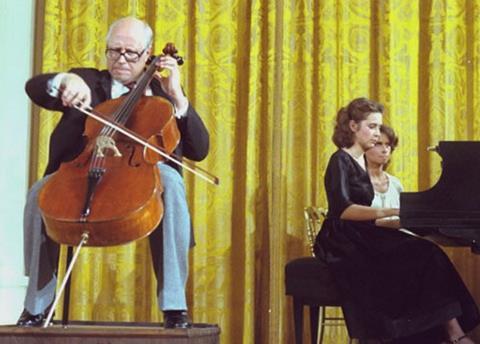Today we’re shining a light on the titan of cello playing, who was born on 27 March 1927

Discover more Featured Stories like this in The Strad Playing Hub
Who was Mstislav Rostropovich?
Born on 27 March 1927 in Baku, Azerbaijan, then a Soviet province, Mstislav Rostopovich was a cellist, conductor and activist whose performances, recordings and collaborations with other musicians and composers made their definitive stamp on 20th-century music. He was described as ‘probably the greatest cellist of all time’ by Julian Lloyd Webber and was a huge influence on cellists following in his footsteps.
Rostropovich begain studying piano with his mother, Sofiya Fedotova, at the age of four. He started playing the cello with his father, Leopold Vitodovich Rostropovich, a cellist himself who was a former student of Pablo Casals. At the age of 16, he entered the Moscow Conservatory where he studied cello, piano and composition. It was here that he encountered the composer Dmitri Shostakovich, who was one of his teachers.
In 1945 at the age of 18, Rostropovich won the gold medal at the Soviet Union’s inaugural competition for young musicians. This sparked a competition-winning streak in young Rostropovich’s early career, winning first prize at the Prague and Budapest International Music Awards on three occasions. He won the Soviet Union’s highest distinction, the Stalin Prize, at the age of 23 and was already making a name for himself as a soloist, as well as a teacher at the Leningrad Conservatory and his alma mater, the Moscow Conservatory.
Why did Rostropovich leave the Soviet Union?
Rostropovich believed in freedom of speech, democratic values and art without borders. This invited investigation from the Soviet regime on numerous occasions. In 1970 he sheltered Russian writer and prominent Soviet dissident Aleksandr Solzhenitsyn, which led to Rostropovich’s restriction on foreign touring. His appearances in Moscow were curtailed, as well as in other cities such as Leningrad and Kiev.
He left the Soviet Union in 1974 with his wife, the soprano Galina Vishnevskaya, and their children and settled in the US. He was faced with a ban from touring his homeland with foreign orchestras and the Soviet leaders instructed musicians not to take part in his competitions. He was eventually stripped of his Soviet citizenship for public opposition of the Soviet Union’s restriction of cultural freedom.
In 1989, Rostropovich gave an impromptu performance at the fall of the Berlin Wall. His Soviet citizenship was reinstated in 1990. When Russia began to struggle with new-found democracy in 1991, Rostropovich flew to Moscow to support the new Russian president, Boris Yeltsin.
Rostropovich’s career and collaborations
Rostropovich had numerous collaborations with contemporary composers, both in the Soviet Union and abroad. With over 100 works written for him, this in turn vastly expanded cello repertoire. Some examples of works written for and premiered by Rostropovich include Sergei Prokofiev’s Cello Sonata op.119 and Symphony Concerto, both cello concertos by Shostakovich, Lutosławski’s Cello Concerto, Benjamin Britten’s solo cello suites and Cello Symphony, and Tout un monde lointain by Henri Dutilleux. He performed with renowned pianists including Marta Argerich, Sviatoslav Richter and Vladimir Horowitz, and formed a trio with pianist Emil Gilels and violinist Leonid Kogan.
In addition to his cello performance career, Rostropovich was a prolific conductor. He served as music director and conductor of the National Symphony Orchestra in Washington D.C from 1977 to 1994 and was director and founder of the Mstislav Rostropovich Baku International Festival. He was part of the artistic direction team of the Aldeburgh Festival after the death of Benjamin Britten in 1976 and was instrumental in the foundation of the Kronberg Academy in 1993.
What cellos did Rostropovich play?
Rostropovich performed on the 1711 ‘Duport’ Stradivari cello, which he acquired in 1974. He had it fitted with a special bent endpin, which helped the cello rest more horizontally against his chest to facilitate left-hand mobility and weight distribution and power in his bow arm.
He also played on the 1684 ‘Visconti’ Stradivari cello, as well as other cellos by Guadagnini, Goffriller, Santo Serafin, Storioni and new instruments by Peresson and Vatelot.
When did Rostropovich die?
Rostropovich’s health declined in 2006. In April 2007, he was treated for intestinal cancer at the Blokhin Russian Cancer Research Centre. He died later that month on 27 April, aged 80. His body lay in an open casket at the Moscow Conservatory the following day, with a funeral attended by world leaders on 29 April. He is buried in Novodevichy Cemetery.
Read: Russian cellist Karine Georgian remembers lessons with Mstislav Rostropovich
Read: My father Slava - by Elena Rostropovich
Read more Featured Stories like this in The Strad Playing Hub
The number one source for playing and teaching books, guides, CDs, calendars and back issues of the magazine.
In The Best of Technique you’ll discover the top playing tips of the world’s leading string players and teachers. It’s packed full of exercises for students, plus examples from the standard repertoire to show you how to integrate the technique into your playing.
The Strad’s Masterclass series brings together the finest string players with some of the greatest string works ever written. Always one of our most popular sections, Masterclass has been an invaluable aid to aspiring soloists, chamber musicians and string teachers since the 1990s.
American collector David L. Fulton amassed one of the 20th century’s finest collections of stringed instruments. This year’s calendar pays tribute to some of these priceless treasures, including Yehudi Menuhin’s celebrated ‘Lord Wilton’ Guarneri, the Carlo Bergonzi once played by Fritz Kreisler, and four instruments by Antonio Stradivari.













































No comments yet